
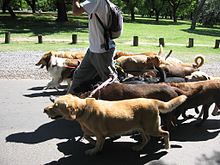
Dog walking is the act of a person walking with a dog, typically from the dog's residence and then returning. Leashes are commonly used for this. Both owners and pets receive many benefits, [1] including exercise and companionship. [2]


Dog walking is the act of a person walking with a dog, typically from the dog's residence and then returning. Leashes are commonly used for this. Both owners and pets receive many benefits, [1] including exercise and companionship. [2]
Dogs are restrained by a collar around their neck or a harness, [3] or by simply following their guardian with familiarity and verbal control. Commonly, the dog is walked by the guardian or another family member, but there are also professional dog walkers. [4]
Dog owners can also go hiking with their dogs. Many trails mandate that the dogs are on leash, in view of the dogs' safety and the safety of other hikers. [5]

A study by Michigan State University showed that people who walk their dogs are 34% more likely to meet expected goals of exercise, with a recommended level of 150 minutes of activity such as dog walking per week. Matthew Reeves, the co-author of the study said, "There is no magic bullet in getting people to reach those benchmarks but walking a dog has a measurable impact." [6]
Research conducted by the University of Western Australia has suggested that a higher rate of dog walking within a community tends to cause more interpersonal relationships within that community. The research suggested that people in the community would acknowledge and greet other people in the street, and exchange favors with neighbors, which could possibly encourage more exercise in the community, by giving pets and owners a chance at a healthier lifestyle.

Professional dog walkers, both individuals and businesses, are paid by dog owners to walk their dogs for them. Some dog walkers will take many dogs for a walk at once, while others will only take a single dog. [4] The length of a walk might vary by breed or owner's request, ranging from short walks intended to last no longer than the time it takes for the dog to relieve itself of waste, to longer walks with a specific amount of time set by the owner. "The length of walks should take into account the dog's age and health status. Long walks (over 1 hour) should not be undertaken by dogs under 12 months of age for smaller breeds, up to 18 months for large breeds, to protect their bones and joints while they are still growing." [7] Also growing in popularity is "dog running". [8] Dog runners are professionals who run with dogs, rather than walking with them. In some jurisdictions, dog walking businesses [9] must be licensed and have employees trained in animal first aid. Professional dog walking services can be obtained locally or through online referral services. Obtaining a position as a professional dog walker has become more demanding, with applicants having to go through extensive training. [10] However, whether or not licensing or training is required, all dog walkers who walk other people's dogs must be aware of best practices such as using a fixed-length leash and weather considerations.
In the United States, the first professional dog walker is believed to have been Jim Buck, who in 1960 launched his dog walking service in New York City. [11]
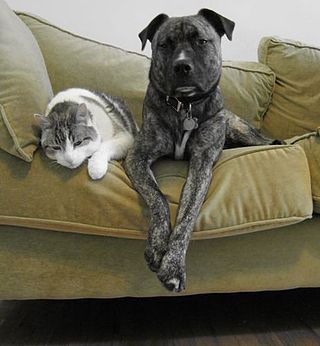
A pet, or companion animal, is an animal kept primarily for a person's company or entertainment rather than as a working animal, livestock, or a laboratory animal. Popular pets are often considered to have attractive/cute appearances, intelligence, and relatable personalities, but some pets may be taken in on an altruistic basis and accepted by the owner regardless of these characteristics.

The Harrier is a medium-sized dog breed of the hound class, used for hunting hares by trailing them. It resembles an English Foxhound but is slightly smaller, though not as small as a Beagle. The breed has been used since the mid 13th century.

Guide dogs are assistance dogs trained to lead blind or visually impaired people around obstacles. Although dogs can be trained to navigate various obstacles, they are red–green colour blind and incapable of interpreting street signs. The human does the directing, based on skills acquired through previous mobility training. The handler might be likened to an aircraft's navigator, who must know how to get from one place to another, and the dog is the pilot, who gets them there safely. In several countries guide dogs, along with most other service and hearing dogs, are exempt from regulations against the presence of animals in places such as restaurants and public transportation.

The Papillon, also called the Continental Toy Spaniel, is a breed of dog, of the spaniel type. One of the oldest of the toy spaniels, it derives its name from its characteristic butterfly-like look of the long and fringed hair on the ears. A Papillon with dropped ears is called a Phalene.

The Cavalier King Charles Spaniel (CKCS) is a British breed of toy dog of spaniel type. Four colours are recognised: Blenheim, tricolour (black/white/tan), black and tan, and ruby; the coat is smooth and silky. The lifespan is usually between eight and twelve years.
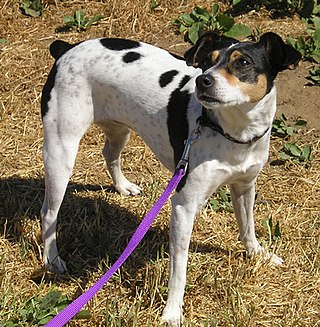
A leash is a rope or similar material used to control an animal by attaching it to a collar, harness, or halter. In British English, a leash is generally for a larger animal, with lead being more commonly used when walking a dog.

A dog park is a park for dogs to exercise and play off-leash in a controlled environment under the supervision of their owners.

The Irish Water Spaniel is a breed of dog that is the tallest of the spaniels.

The Small Münsterländer is a versatile hunting-pointing-retrieving dog breed that reached its current form in the area around Münster, Germany. The Large Münsterländer is from the same area, but was developed from different breeding stock and is not related as the names would suggest. Small Münsterländers bear a resemblance to both spaniels and setters but are more versatile while hunting on land and water. The Small Münsterländer is recognized by the Fédération Cynologique Internationale under Group 7, Section 1.2, Continental Pointing Dogs of Spaniel type, by the American Kennel Club as a Foundation Stock Service breed, and by The Kennel Club and the United Kennel Club as a gun dog. It is related to the Epagneul Français and the Drentsche Patrijshond.
A dog collar is a piece of material put around the neck of a dog. A collar may be used for restraint, identification, fashion, protection, or training. Identification tags and medical information are often placed on dog collars. Collars are often used in conjunction with a leash for restraining a dog. Collars can be traumatic to the trachea if the dog pulls against the restraint of the leash, causing severe pressure to the neck. Use of a harness instead of a collar may be beneficial for dogs prone to tracheitis or those with a collapsed trachea. Conversely, dog breeds with slender necks or smaller heads may easily slip out of collars that are too loose. This can be avoided by using a martingale dog collar which tightens to distribute pressure around the neck when training the dog not to pull. Any style of dog collar must be properly fitted to ensure safety and collars should not be worn when the dog is unattended.
Pet sitting is the act of temporarily taking care of another person's pet for a given time frame. It commonly occurs at the pet owner's home, but may also occur at the provider's home or at a pet sitting place of business or organization. Pet sitting is a more personal and individualized arrangement for care compared to boarding or kenneling. Specialized training is usually not required for pet sitting.
An obedience trial is a dog sport in which a dog must perfectly execute a predefined set of tasks when directed to do so by his handler. According to the American Kennel Club (AKC) obedience regulations
The basic objective of obedience trials, however, is to recognize dogs that have been trained to behave in the home, in public places, and in the presence of other dogs, in a manner that will reflect credit on the sport of obedience at all times and under all conditions.

Point Isabel Regional Shoreline in Richmond, California, is operated by East Bay Regional Park District, and is a multi-use park for joggers, windsurfers, kayakers, photographers, picnickers, and people walking dogs. It has access for pedestrians and via public transit, private vehicles, and bikes. It also features a concession offering food for people and grooming for pets. A longtime community organization and nonprofit, Point Isabel Dog Owners and Friends (PIDO), is active in the maintenance and improvement of the park.
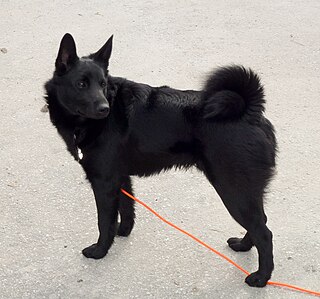
The Black Norwegian Elkhound is a small Spitz breed classified by the FCI as a hunting dog. It is currently an uncommon breed in Norway and very rare outside the Nordic countries of Scandinavia. It is a sibling breed to a Grey Norwegian Elkhound, but is smaller, more agile, doesn't bark and was bred explicitly for on-leash dog hunting.
Temperament tests assess dogs for certain behaviors or suitability for dog sports or adoption from an animal shelter by observing the animal for unwanted or potentially dangerous behavioral traits, such as aggressiveness towards other dogs or humans, shyness, or extreme fear.
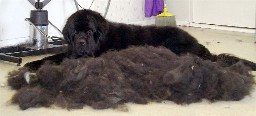
Dog grooming refers to the hygienic care of a dog, a process by which a dog's physical appearance is enhanced for showing or other types of competition. A dog groomer is a professional responsible for maintaining a dog’s hygiene and appearance by offering services such as bathing, brushing, hair trimming, nail clipping and ear cleaning.

The bloodhound is a large scent hound, originally bred for hunting deer, wild boar, rabbits, and since the Middle Ages, for tracking people. Believed to be descended from hounds once kept at the Abbey of Saint-Hubert, Belgium, in French it is called, le chien de Saint-Hubert.
Jim Buck was a New York City dog walker.

Wag Labs is an American pet care company that offers a technology platform to connect pet owners with independent pet professionals for on-demand and scheduled dog walking, training, and other petcare services through a mobile application. The app has been referred to as "the Uber for Dogs".

The Behaviour and Personality Assessment in Dogs, commonly abbreviated as BPH, is a behavioural assessment developed by the Swedish Kennel Club (SKK) in May 2012 that aims to accurately describe the personality of a dog irrespective of whether it is a working, pet or breeding dog. It was developed with the intention to afford breeders, owners and kennel clubs better knowledge of dog mentality so that they can breed dogs with more favourable behaviour and understand more about their dog.